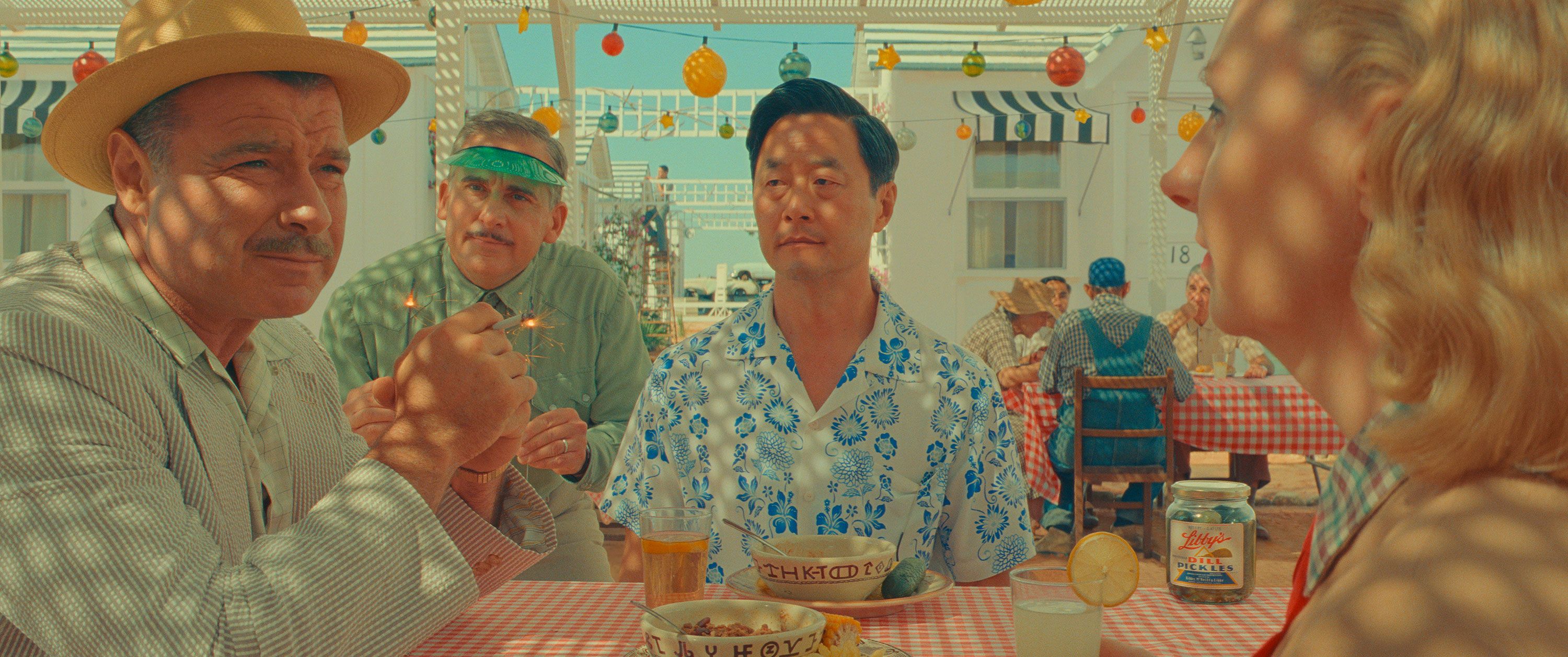← Back to Reviews
in
Asteroid City
The ridiculously endless imagination of Wes Anderson is in serious overdrive with one of his most ambitious and challenging undertakings. The 2023 film Asteroid City is a one-of-a-kind celluloid experience that defies genre classification and breaks a lot of basic movie-making rules, but if it didn't, it wouldn't be a Wes Anderson movie. It does require undivided attention and perhaps makes the viewer work a little too hard to keep up.

The story begins with a narrator (Bryan Cranston) onstage at a theater introducing us to a playwright named Conrad Earp (Edward Norton) who then proceeds to introduce the viewer to the characters in his latest play called Asteroid City. The central characters and hook for the story are a recently widowed photographer named Augie (Jason Schwartzman) with four children who arrive in the title city, population 87, where the widower finally tells his children that their mother has died and he has her remains in a tupperware container. Augie then calls his father-in-law (Tom Hanks) to come take care of his granddaughters while his son participates in a science contest and Augie finds himself drawn to a suicidal method actress (Scarlett Johanssen).

We then observe Augie and his family are among several bizarre characters who have arrived in Asteroid City for multiple reasons, including the recent landing of an asteroid in the area and a visit from an alien, who steals the asteroid, which prompts a quarantine from the government not allowing the residents of Asteroid City to go anywhere.

Anderson and co-screenwriter Roman Coppola have crafted a piece that seems to be an overly elaborate valentine to The Twilight Zone. Cranston's narrator seems to be channeling Rod Serling in a story that obliterates the concept of the 4th wall as his introduction of the playwright seems to take him out of the narrative, which the playwright passes onto his characters. Though we are provided with program cards that remind us what act of the play we're in and the two or three scenes we are about to watch. As a matter of fact, at the end of the first act, the program says "intermission optional.": There is wonderful moment where Cranston's character steps into the middle of the play and when characters are confused by his presence, he sheepishly steps out of the scene. Then when we think we have settled into the onscreen madness, the third act invites us backstage where we not only meet the director (Adrien Brody), but an actress whose role was cut before the play opened (Margot Robbie).

As always with Anderson, the film is a visual feast, but the look is something different that I found difficult to pinpoint at first, but about 30 minutes in, I figured it out. The scenery upon which most of the story plays is theatrical scenery, actual flats mounted on a proscenium that are revealed at the beginning of the third act that actual define a phrase I have used in a lot of my reviews..."photographed stage play."

Anderson's direction is crisp and offers consistent surprises that keep the viewer on guard. Most of Anderson's rep company is on hand here, with the exceptions of Owen Wilson and Bill Murray, whose roles seem to have been inhabited by Matt Dillon and Steve Carell. According to the IMDB, Carell replaced Murray when he contracted Covid. Scwartzman and Johanssen command the screen whenever they're on and I would like to nominate Jeffrey Wright and Edward Norton for new members of the Anderson rep company.
The ridiculously endless imagination of Wes Anderson is in serious overdrive with one of his most ambitious and challenging undertakings. The 2023 film Asteroid City is a one-of-a-kind celluloid experience that defies genre classification and breaks a lot of basic movie-making rules, but if it didn't, it wouldn't be a Wes Anderson movie. It does require undivided attention and perhaps makes the viewer work a little too hard to keep up.

The story begins with a narrator (Bryan Cranston) onstage at a theater introducing us to a playwright named Conrad Earp (Edward Norton) who then proceeds to introduce the viewer to the characters in his latest play called Asteroid City. The central characters and hook for the story are a recently widowed photographer named Augie (Jason Schwartzman) with four children who arrive in the title city, population 87, where the widower finally tells his children that their mother has died and he has her remains in a tupperware container. Augie then calls his father-in-law (Tom Hanks) to come take care of his granddaughters while his son participates in a science contest and Augie finds himself drawn to a suicidal method actress (Scarlett Johanssen).

We then observe Augie and his family are among several bizarre characters who have arrived in Asteroid City for multiple reasons, including the recent landing of an asteroid in the area and a visit from an alien, who steals the asteroid, which prompts a quarantine from the government not allowing the residents of Asteroid City to go anywhere.

Anderson and co-screenwriter Roman Coppola have crafted a piece that seems to be an overly elaborate valentine to The Twilight Zone. Cranston's narrator seems to be channeling Rod Serling in a story that obliterates the concept of the 4th wall as his introduction of the playwright seems to take him out of the narrative, which the playwright passes onto his characters. Though we are provided with program cards that remind us what act of the play we're in and the two or three scenes we are about to watch. As a matter of fact, at the end of the first act, the program says "intermission optional.": There is wonderful moment where Cranston's character steps into the middle of the play and when characters are confused by his presence, he sheepishly steps out of the scene. Then when we think we have settled into the onscreen madness, the third act invites us backstage where we not only meet the director (Adrien Brody), but an actress whose role was cut before the play opened (Margot Robbie).

As always with Anderson, the film is a visual feast, but the look is something different that I found difficult to pinpoint at first, but about 30 minutes in, I figured it out. The scenery upon which most of the story plays is theatrical scenery, actual flats mounted on a proscenium that are revealed at the beginning of the third act that actual define a phrase I have used in a lot of my reviews..."photographed stage play."

Anderson's direction is crisp and offers consistent surprises that keep the viewer on guard. Most of Anderson's rep company is on hand here, with the exceptions of Owen Wilson and Bill Murray, whose roles seem to have been inhabited by Matt Dillon and Steve Carell. According to the IMDB, Carell replaced Murray when he contracted Covid. Scwartzman and Johanssen command the screen whenever they're on and I would like to nominate Jeffrey Wright and Edward Norton for new members of the Anderson rep company.
